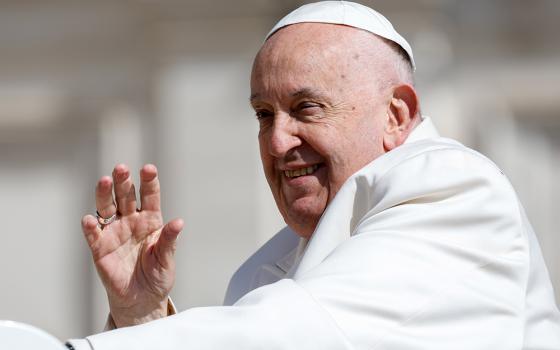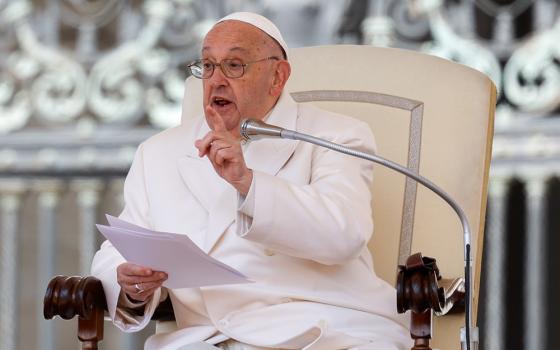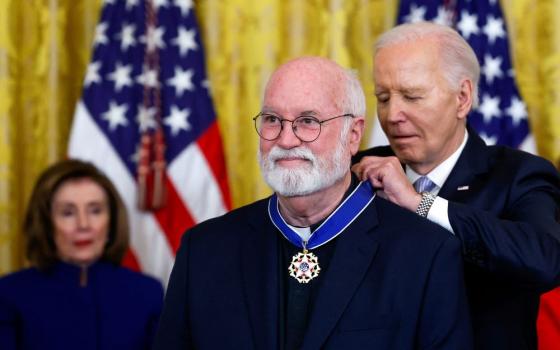Pope Francis shares a laugh with officers of the U.S. Leadership Conference of Women Religious during a meeting in the library of the Apostolic Palace at the Vatican March 21, 2024. From the left are: Dominican Sr. Maureen Geary, LCWR president; Dominican Sr. Rebecca Ann Gemma, past president; Sr. Sue Ernster, a member of the Franciscan Sisters of Perpetual Adoration and LCWR president-elect; and Sr. Carol Zinn, a Sister of St. Joseph of Philadelphia and LCWR executive director. (CNS/Vatican Media)
Editor's note: Global Sisters Report, the dynamic online community that reports on and gives voice to Catholic women religious around the world, is celebrating its 10th anniversary this year. Join us as we take another look at stories and columns published in 2014 with new updates and reporting.

In a sense, Global Sisters Report began at the end: The first year of its publication saw the end of both the apostolic visitation of all women religious in the United States and the doctrinal assessment of the Leadership Conference of Women Religious specifically.
Both had been going on for more than five years.
The Vatican investigations were controversial, with more progressive Catholics seeing them as an attack on women who had dedicated their lives to the church, and more traditional Catholics seeing them as a needed correction for religious who had become too secular.
But the apostolic visitation ended Dec. 16, 2014, with a report largely praising sisters' faithfulness and contribution to the church. The doctrinal assessment of LCWR ended April 16, 2015, with a joint report that again praised their faithfulness and contributions.
A decade after those tense times before the reports were issued, sisters say their relationship with officials in Rome is radically different.
Sr. Marlene Weisenbeck, a Franciscan Sister of Perpetual Adoration, was president-elect of LCWR when the doctrinal assessment was launched. (CNS/Courtesy of LCWR)
"It's a different time," said Sr. Marlene Weisenbeck, a Franciscan Sister of Perpetual Adoration who was president-elect of LCWR when the doctrinal assessment was launched and became president a few months later. "There are new people in the dicasteries, we have a new pope who has led the church on the basis of being close to one another and being transparent. … It's a different time and the agenda has changed."
Margaret Susan Thompson, a historian at Syracuse University who has examined Catholic nuns in the United States, said that while leadership in the Vatican had already begun to change — both the prefect and secretary of the Congregation for the Institutes of Consecrated Life and Societies of Apostolic Life, which was conducting the apostolic visitation, had been replaced with bishops seen as friendlier to women religious — the 2013 retirement of Pope Benedict XVI and election of Pope Francis cannot be discounted.
"I think both (investigations) were less of a big deal than most American sisters feared they would be when they were initiated, and that is, of course, because of Pope Francis," Thompson said. "The whole tenor of the Vatican, in particular toward religious life, changed radically."
'The most important thing that happened was that the sisters learned how to be true to ourselves. We rediscovered the heart of our lives.'
—Sr. Mary Ann Zollman
Weisenbeck said the relationship between sisters in the United States and Rome has gone from confrontational to collaborative, noting that the dicasteries are working with sisters to solve problems related to changing demographics, such as a lack of sisters able to be in leadership.
"It shows the dicastery is willing to be involved in the discussions and solicit opinions," she said. "It's the other side of the coin."
Sr. Mary Ann Zollman, one of the authors of the 2014 book Power of Sisterhood: Women Religious Tell the Story of the Apostolic Visitation, said the Vatican has become more of a partner in the evolution of religious life and less of an impediment. Zollman was president of the Sisters of the Charity of the Blessed Virgin Mary at the time of the visitation, and was LCWR president in 2002.
"They're leaving us free to do what we need to do in these times that are very challenging for us. I think Rome is watching with curiosity as to what the next unfolding in this life is going to be in us and because of us," Zollman said. "Rome is asking specifically for women's congrations' responses for the synod — they realize we are a vital, vibrant, essential part of the furthering of the life of this church."
A woman religious prays Sept. 21, 2018, during the Fifth National Encuentro in Grapevine, Texas. (CNS/Tyler Orsburn)
That wasn't always the case.
"I remember visits to Rome that were terribly painful," Zollman said. "They're not like that for LCWR now."
Global Sisters Report asked LCWR for comment on how its relationship with the church hierarchy has changed, but officials declined to make officers available, saying they "do not feel it is helpful to revisit the relationship LCWR had with the Vatican during the time of the doctrinal assessment and compare it to how it is now."
'I think the Vatican was afraid of U.S. women religious. We took Vatican II seriously, we renewed. We were changed. The problem is the Vatican didn't do as much renewal as they told everyone else to do.'
—Sr. Simone Campbell
Sr. Simone Campbell, a Sister of Social Service who was executive director of Network, the Catholic social justice lobby, when it was named in the doctrinal assessment, said the change can be seen in Francis' work at synodality, his making women full voting members of the Synod of Bishops, and his appointment of women to several important posts in the Vatican.
"The struggle is that it doesn't always trickle down to all the dioceses and all the parishes in the church," Campbell said.
Zollman said the investigations brought sisters together and refocused their energies.
"The most important thing that happened was that the sisters learned how to be true to ourselves. We rediscovered the heart of our lives," Zollman said. "We connected with our own communities, we established new and lasting relations with women from other congregations, and we talked with the laity about what religious life is all about."
Sr. Sharon Holland (left), then president of the Leadership Conference of Women Religious, speaks as Sr. Agnes Mary Donovan, coordinator of the Council of Major Superiors of Women Religious, listens during a Dec. 16, 2014, Vatican press conference for release of the final report of a Vatican-ordered investigation of U.S. communities of women religious. The visitation was carried out between 2009 and 2012. (CNS/Paul Haring)
Then-LCWR President Sr. Sharon Holland, an Immaculate Heart of Mary sister and canon lawyer who spent 21 years as one of the highest-ranking women in the Vatican, told the group's 2015 assembly the investigations were caused by a "cultural chasm" between sisters and the church hierarchy.
"We somehow were looking at the same realities, but we were standing in different places," she said in her presidential address. "We didn't realize that we were experiencing the incomprehension of two groups who did not know each other's deeper assumptions. We risked slipping into talking about each other instead of talking more deeply with each other."
Brazilian Cardinal Joao Braz de Aviz, prefect of the Congregation for Institutes of Consecrated Life and Societies of Apostolic Life, holds the final report of a Vatican-ordered investigation of U.S. communities of women religious at the conclusion of a Dec. 16, 2014, Vatican press conference. The visitation was carried out between 2009 and 2012. (CNS/Paul Haring)
Sr. Carol Zinn, a Sister of St. Joseph of Philadelphia who was LCWR president in 2013 and is now the group's executive director, wrote in However Long the Night: Making Meaning in a Time of Crisis, the book LCWR published about the doctrinal assessment, that it quickly became apparent that much of the conflict was about the reform sisters believed Vatican II demanded of religious life and traditionalists who opposed it.
"From the very beginning of our work with the mandate (the 2012 Vatican directive demanding changes at LCWR) it was clear to us that this mandate did not exist in a vacuum and that while it was directed to LCWR, it was really about issues, perceptions, and realities that went beyond LCWR," Zinn wrote. "We were not the only ones who felt unheard or dismissed, had been identified as being unfaithful to church teaching, or were struggling to find a safe place where conversations about faith could happen with respect for diversity and genuine search for meaning. We were not the only ones who held a deep hope in the vision of a Vatican II church and world."
Advertisement
That hope was not held by many in authority at the time of the investigations, Campbell said.
"I think the Vatican was afraid of U.S. women religious," she said. "We took Vatican II seriously, we renewed. We were changed. The problem is the Vatican didn't do as much renewal as they told everyone else to do."
Thompson said one of the biggest reasons for the changing relationship is that Francis and other key decision-makers were members of religious congregations themselves.
"I think that made a big difference," she said. "He was able to understand the complexities of the issues from the inside in a way Benedict and the bishops in the United States were not capable of doing."
Weisenbeck said one of the gifts of that time was a new relationship between religious and the laity.
"The support of the laity was just overwhelming," she said. "We have such gratitude for the laity that supported us."











